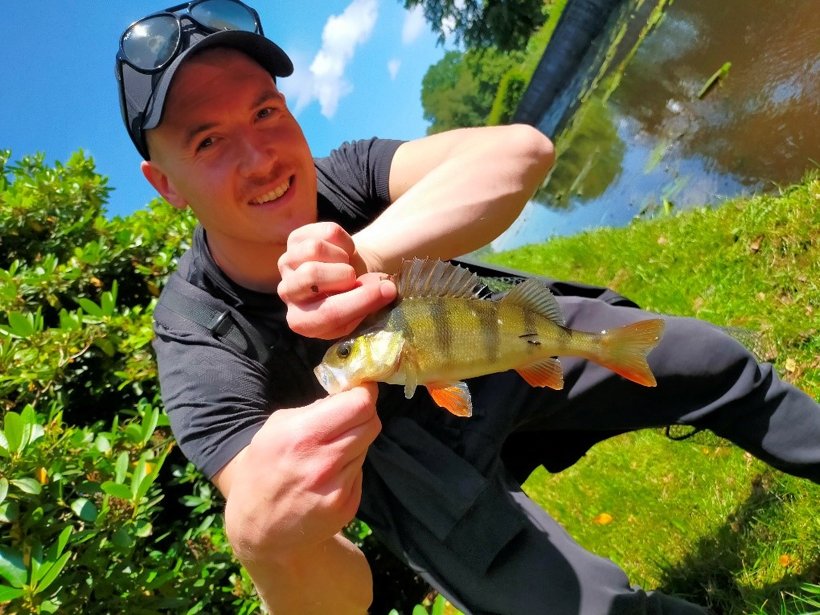On a sunny summer day, anyone glancing at the ponds at the University of Twente will see that they are teeming with fish. Predatory fish play an essential role in maintaining a healthy fish population on campus, as many fish species are on the menu for these predators. But which predatory fish can actually be found in our waters? Where do they hide? And how can you catch them?
In our waters, you’ll find two dominant species: the pike (Esox lucius) and the perch (Perca fluviatilis). To our knowledge, there are no zander (Sander lucioperca) or predatory bream (Leuciscus aspius) in our ponds. Zanders prefer deeper and/or murky waters like lakes, ponds, rivers, and canals, while predatory bream are typically found in rivers and connected waters.
How to Recognize These Predators?
Pike (Esox lucius)
The pike can be recognized by its torpedo-shaped body, large head, and mouth full of razor-sharp teeth. It is often greenish or brownish in color, with a pattern of yellow-golden spots. Males typically grow to about 80 cm, while females can grow even larger. The largest pike ever caught in the Netherlands measured an impressive 138 cm!
The diet of the pike consists of various fish species. Cannibalism is not uncommon for these fish. Additionally, pike also eat frogs, salamanders, small mammals, and small (water)birds. It is not uncommon for someone to spot a pike launching itself out of the water to catch a young duckling.

The pike can be recognized by its torpedo-shaped body, large head and yellow-gold spots
Perch (Perca fluviatilis)
The perch is recognizable by its large mouth, blunt head, and high back with two dorsal fins. The front dorsal fin has hard spines with a black spot at the back. Perches are greenish or brownish in color, with orange fins and a vertical pattern of dark stripes. The largest perch ever caught in the Netherlands was 56 cm long. Its diet mainly consists of fish, and like pike, perches have no problem eating their smaller relatives.

The perch can be recognized by its large mouth, blunt head, large dorsal fin with spines, orange fins and a beautiful striped pattern on the body.
Where do they hide?
Pike hunt alone and prefer to hide. If you look carefully, you might spot them among aquatic plants, near bridges, close to the shore, under platforms, at the bottom of embankments, or among underwater structures. In these areas, the pike lies in ambush, waiting for its prey. On a sunny day, pike can also be seen in clear water.
Perch prefer the same hiding spots as pike, but they tend to inhabit shallower waters. However, perch hunt in large schools. Larger perch hunt in smaller groups or alone. You can often find them in large numbers, so they are easy to spot in clear water on a sunny day.
How to catch them?
To fish for pike and perch, you must always have a valid fishing permit. If you want to fish on our campus, you need to be a member of and follow the rules of HSV Carperdiem.
As mentioned earlier, the pike has a varied diet. Additionally, pike are particularly aggressive and territorial, which means they will strike at anything that comes their way. Artificial lures are commonly used for pike fishing. Additionally, anglers often use dead freshwater fish (such as roach) and strongly scented sea fish (like mackerel).
The pike is a sight predator, best caught in the early mornings and evenings during June, September, October, November, December, and January. From March until the last Saturday of May, there is a closed season to protect the pike during spawning. During this period, fishing with artificial lures is prohibited from April onward.
Perch is also often caught using smaller lures, such as fish- or worm-shaped baits, or with maggots and earthworms under a float. The closed season for perch is the same as for pike. For more information, visit the Sportvisserij Nederland website.
Want to learn more about pike and perch? Or are you interested in fishing in our ponds? Feel free to contact us.
On 6 September 2025, HSV Carperdiem will celebrate its 55th anniversary with a fun activity. Are you an employee or student at the University of Twente and do you have a passion for fishing? Then sign up for our association now by clicking on the following link: https://www.utwente.nl/nl/ut-kring/subverenigingen/subverenigingen-websites/website-carperdiem/aanmelden/.
Biodiversity at UT
Strengthening biodiversity on our campus is one of our sustainability goals at the University of Twente. By improving monitoring, we gain knowledge about biodiversity on campus in general, which helps us decide on the best ways to support it. In 2024, we started the yearly Bioblitz, in which anyone can help monitor species via the app ObsIdentify. Several activities were organised to raise awareness of biodiversity (such as bird observation). A biodiversity council was established, where CFM (Campus & Facility Management) consult with biodiversity enthusiasts on how maintenance can contribute to an improved habitat for species. Furthermore, thanks to a Climate Centre grant, we are working on making data on green maintenance and biodiversity accessible for research and education.
Would you like to find out more about sustainability at UT? Please go to utwente.nl/sustainability.





